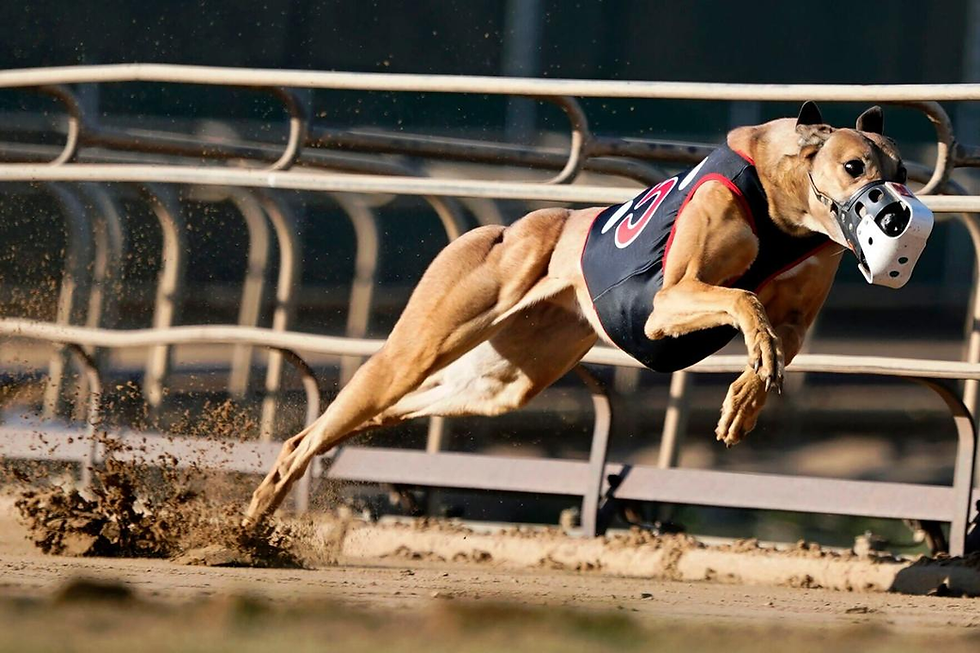Greyhounds: majestic athletes or prisoners of the industry? The debate that divides
- Topon Tarosuyo

- Feb 16
- 4 min read
The greyhound, often hailed as one of the fastest dog breeds in the world, is a creature of remarkable beauty and athleticism. Known for their slender frame and unmatched speed, these dogs have been bred for one thing: racing. On the tracks, they appear to glide effortlessly, showcasing an elegance that seems almost out of place in such a competitive environment. But beneath their sleek coats and lightning-fast runs lies a question that many are too afraid to ask: are these greyhounds truly athletic champions, or are they mere pawns in a cold, profit-driven industry?
The greyhound racing world is often portrayed as a glamorous sport, with sleek dogs speeding around tracks for the thrill of the crowd. However, a darker reality lurks behind the scenes. For every greyhound that crosses the finish line in first place, many others suffer injuries, exhaustion, and ultimately, abandonment once their racing careers are over. This has sparked a fierce debate about the ethics of greyhound racing and whether these majestic dogs are truly treated as athletes, or whether they are nothing more than expendable tools of an industry that values profit over their well-being.
The athlete, but at what cost?
When we think of greyhounds, we often picture them as athletic machines, built for speed and competition. With their long, slender legs and aerodynamic bodies, they are perfectly suited to the racetrack. In fact, a greyhound can reach speeds of up to 70 km/h (45 mph), making them one of the fastest dog breeds in the world. However, this incredible speed and agility come at a price.
Greyhounds are often subjected to grueling training regimes that push their bodies to the limit. From a young age, these dogs are conditioned for speed, undergoing intense workouts and competing in races that sometimes exceed their physical capabilities. This demanding lifestyle can lead to severe injuries, including broken legs, muscle strains, and joint problems. But the industry's focus is not on the long-term health of the dog; it is on the immediate return from the race. Once a greyhound is no longer seen as a top contender, it is often discarded, left to face an uncertain future. In some cases, these once-glorious dogs are abandoned, euthanized, or forced into retirement in shelters, where they face the possibility of a life in obscurity.
While some may argue that greyhounds enjoy the thrill of the chase, it is difficult to ignore the mounting evidence that many dogs in the racing industry live in poor conditions, suffering from neglect and mistreatment. In addition, the intense pressure to perform often leads to the use of drugs and performance enhancers, which further compromise the dogs' health and well-being. The question remains: are these dogs truly athletes, or are they simply exploited for their speed, only to be discarded once they are no longer profitable?
The dog after the race: a life of uncertainty
For many greyhounds, life after the race is a grim reality. Once they can no longer perform at their peak, they are often seen as liabilities, discarded by the racing industry like worn-out tools. While some dogs are adopted into loving homes, many others are left in shelters, where their future is uncertain. The greyhound racing industry has been criticized for failing to provide adequate aftercare for these dogs, and the high rate of euthanasia among retired racers is a disturbing reflection of the industry's indifference to the welfare of the animals it profits from.
Greyhounds are gentle, loving dogs by nature, but their years in the racing industry often leave them with physical and emotional scars. Many greyhounds suffer from post-traumatic stress disorder (PTSD), as well as physical injuries that require long-term care. The idea that these dogs, who once raced for glory, are now relegated to the shadows, waiting for a chance at a better life, is a heartbreaking reality that the public often fails to see. The industry claims to take care of its retired athletes, but the numbers paint a different picture.

The verdict: greyhound racing—a tradition of exploitation?
The greyhound racing industry has a long history, and many fans of the sport continue to defend its practices, arguing that it is a tradition that should be preserved. They claim that greyhounds enjoy the races and that their speed and agility make them natural-born competitors. However, this view is increasingly being challenged by animal rights groups and concerned individuals who argue that greyhounds are being exploited for the entertainment of others. The reality is that these dogs are often subjected to harsh conditions, living in cages and being pushed to the limit for the sake of profit.
As the debate rages on, one thing is clear: the greyhound, a majestic and athletic dog, is at the center of a storm. The question of whether these dogs are truly athletes or victims of an exploitative industry is one that continues to divide opinion. The answer may lie somewhere in between, but the growing awareness of the challenges faced by retired greyhounds is pushing the industry to reconsider its practices.
Greyhounds may be born to run, but it is up to society to decide whether they will continue to be treated as athletes worthy of respect or as mere commodities to be used and discarded once their usefulness has expired.
Comments